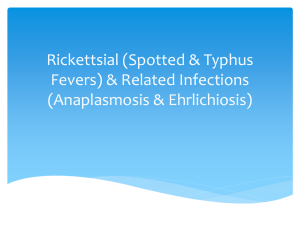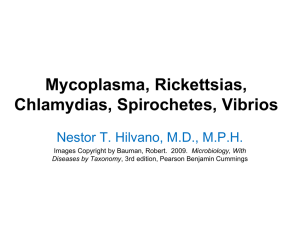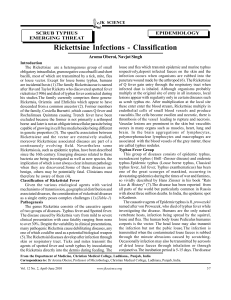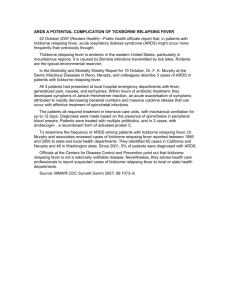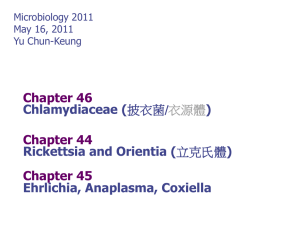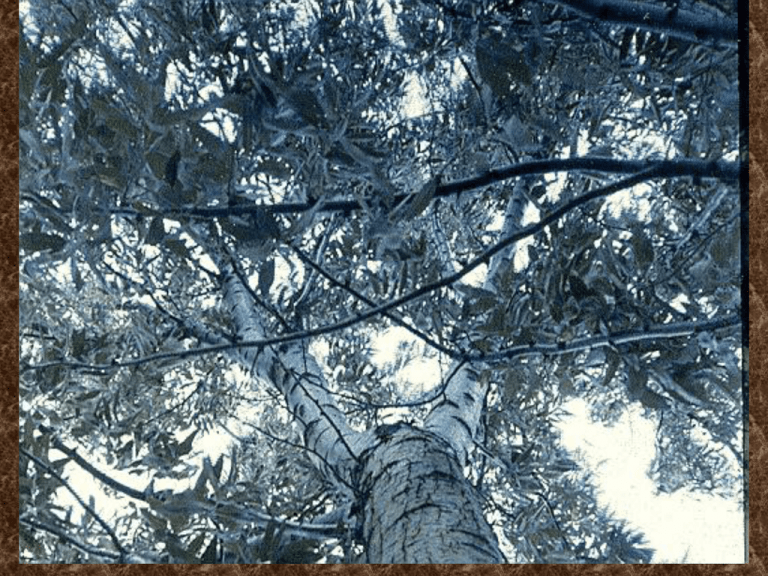
Rickettsia
• Group of bacteria that are fastidious,
obligate intracellular pathogens
• They are pleomorphic & coccobacillary
• The organisms will not show up on Gram
stain, but can be seen when either Gimenez
or Giemsa stains are used
Why Rocky Mountain
Spotted Fever?
• Prototype rickettsiosis
• Main reason for deaths?
Etiology: Invertebrates
1. Rickettsia rickettsiae
2. Ticks (tolerate infection)
– Dermacentor andersonii,
D. variabilis (“hard”)
– Transstadial, transovarial
transmission
Etiology
Microbe
Vector
Reservoir
Host
R. rickettsii
Tick
Rodents
Intruder
Person
• Outdoor activity
• Peak age 5-9
• Mortality highest
in elderly
Development of illness
• Inoculation
• Rickettsemia
• Endothelial localization
• Vasculitis
Clinical recognition
•
•
•
•
Rash
Fever
Headache
Other
Fever and headache
• Fever
–102 to 105 degrees
–2 to 3 weeks without
treatment
• Headache: severe
Clinical recognition
•
•
•
•
Rash
Fever
Headache
Other
Clinical recognition
•
•
•
•
Rash
Fever
Headache
Other
Laboratory diagnosis
• Skin biopsy:
immunofluorescent stain
• Serology
–Weil-Felix archaic
–Immunofluorescent
antibody
• No growth on routine culture
Prevention
• Vector control impractical
• Vaccine unavailable
• So . . . caution outdoors
–Long clothing
–Skin inspection
Rocky Mountain Spotted Fever
•
•
•
•
•
•
Physician suspicion crucial
R. rickettsii, ticks
Not just Rockies
Vasculitis
Rash, fever, headache
Doxycycline, look for ticks
Rickettsiae & spirochetes
• Rocky Mountain Spotted
Fever
• Rickettsial biology
• Other rickettsioses
• Spirochetes
Order Rickettsiales
• Family Rickettsiaceae
–Tribe Rickettsiae
•Genus Rickettsia
•Genus Coxiella
•Genus Rochalimaea
• Family Bartonellaceae
• Spotted Fever Group
• Rocky Mountain spotted fever – Rickettsia rickettsii
• Rickettsial pox – Rickettsia akari
• Canadian typhus – Rickettsia canada
• Mediterranean spotted fever – Rickettsia conorii
• Siberian tick typhus – Rickettsia siberica
• Queensland tick typhus – Rickettsia australis
• Murine typhus (also known as endemic typhus
and fleaborne typhus) – Rickettsia mooseri (typhi)
• • Epidemic typhus (also known as Brill- Zinsser
disease and louseborne typhus) – Rickettsia
prowazekii
• • Scrub typhus (or Chigger fever) – Rickettsia
tsutsugamushi
Rickettsial groups
• Spotted fever group
–Rocky Mountain Spotted Fever
–Other spotted fevers
–Rickettsialpox
• Typhus group
–Epidemic typhus, Brill-Zinsser
–Murine, scrub typhus
Typical rickettsial illness
• Inoculation eschar
(exception: Rocky Mountain
Spotted Fever)
• Rickettsemia
• Endothelial growth
• Vasculitis
• 1-2 week incubation
• Rash, fever, headache
Rickettsial diagnosis
• Must suspect clinically
• Immunoflorescent stained skin
biopsy
• Weil-Felix passé
• Serology usually (but delay in
getting results)
• Isolation hazardous
• Rule out others
Rickettsial control
• Public health
–Reporting
–Vector/reservoir
• No vaccines
Rickettsial diseases other than
Rocky Mountain Spotted Fever
• Other spotted fevers (in
other parts of world)
• Rickettsialpox (urban, from
mice and mites)
• Typhus group (epidemic
typhus from lice)
Other rickettsioses
• Vector (often tick)
• Eschar, rickettsemia
• Vasculitis, serologic test
• Includes spotted fevers,
rickettsialpox, typhus
group
Typical Eschar at Tick Bite
Site
Rickettsiae & spirochetes
• Rocky Mountain Spotted
Fever
• Rickettsial biology
• Other rickettsioses
• Spirochetes
Vincent’s infection/Trench mouth
Necrotizing ulcerative gingivitis
• Synergistic gum infection
• Occurs in poor oral
hygiene, malnutrition,
immunocompromise
• Penicillin, oral hygiene
Relapsing Fever
Epidemic
Endemic
•
•
•
•
B. recurrentis
Lice
Human-lice
E. Africa,
Andes
•
•
•
•
Borrelia spp
Ornithodoros tick
Human intruder
Worldwide: High,
warm, humid
Relapsing fever
pathogenesis
• Spirochetemia
• Sequestration
• Antigenic modification
• Widespread (liver, spleen,
CNS, heart, GI, kidney)
Relapsing fever presentation
• Abrupt fever, malaise,
headache
• Arthralgia, cough, photophobia
• Conjunctival suffusion
• Petechiae
• Abdominal tenderness
Relapsing fever
•
•
•
•
•
Recovery in 3-6 days
Relapse in 7-10 days
Untreated, 40% die
Blood smear positive 70%
Tetracycline,
chloramphenicol
Lyme disease, United States
Lyme disease cases
by month, US, 1999
3000
2000
1000
0
Jan Feb Mar Apr May Jun Jul Aug Sep Oct Nov Dec
Erythema chronicum
migrans
Lyme diagnosis and
treatment
• Clinical, with special serology
• Treatment depends on stage
–Doxycycline, amoxicillin,
cefuroxime
–IV penicillin or ceftriaxone
(later)
Tick repellent
• DEET
–Skin, clothing
–CNS toxicity (directions)
• Permethrin: Clothing
Key points: Lyme disease
• Tickborne B. burgdorferi
• Local: Erythema migrans
• Dissem: Heart, nerve, joint
• Persist: Fatigue, joint
• Doxycycline, ceftriaxone
Frontiers of prevention
• Vaccine: Withdrawn
• Tick avoidance
Many spirochetes tickborne
• Not tickborne
–Syphilis: Sex
–Leptospirosis: Animal urine;
early conjunctival suffusion,
later liver & kidneys
• Tickborne: Borrelia relapsing
fever, change antigens & relapse
Spirochetal disease parallels
Lyme (& Syphilis)
Initial rash: Erythema chron. mig.
2º stage: Nerves, heart, joints
Late stage: Arthritis, fatigue
Treatment: Penicillin, tetracycline
Rickettsia and spirochetes
• Rocky Mountain Spotted
Fever
–Headache, rash, fever
–Tickborne
–No growth on routine
culture
–Doxycycline
Rickettsia and spirochetes
• Other rickettsia
–Poor extracellular
survival
–Suspect clinically
–Typhus: humans, lice
Spirochetes
• Sequestration, antigenic
change in relapsing fever
• Erythema chronicum
migrans, tick in Lyme



